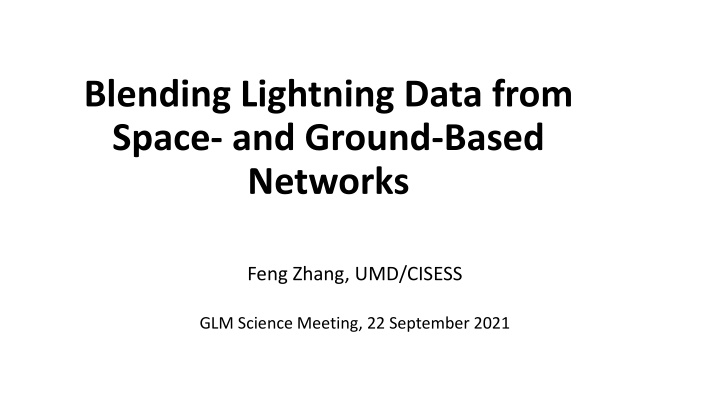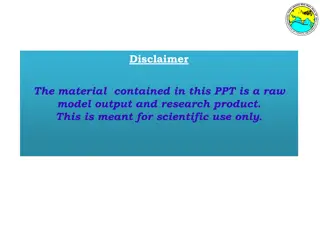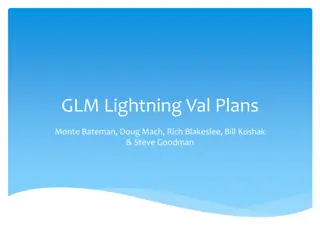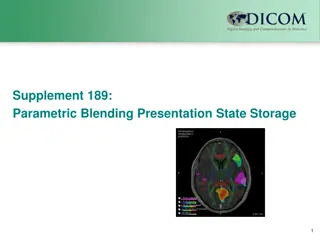Blending Lightning Data from Space and Ground-Based Networks
This project aims to generate a blended dataset combining GLM gridded products with ground-based lightning observations to enhance data assimilation efforts. By leveraging the strengths of both observing platforms, a concise and informative lightning product will be produced for assimilation purposes.
Download Presentation

Please find below an Image/Link to download the presentation.
The content on the website is provided AS IS for your information and personal use only. It may not be sold, licensed, or shared on other websites without obtaining consent from the author.If you encounter any issues during the download, it is possible that the publisher has removed the file from their server.
You are allowed to download the files provided on this website for personal or commercial use, subject to the condition that they are used lawfully. All files are the property of their respective owners.
The content on the website is provided AS IS for your information and personal use only. It may not be sold, licensed, or shared on other websites without obtaining consent from the author.
E N D
Presentation Transcript
Blending Lightning Data from Space- and Ground-Based Networks Feng Zhang, UMD/CISESS GLM Science Meeting, 22 September 2021
Purpose Generate a blended dataset that combines GLM gridded products with ground-based lightning observations to support data assimilation efforts. Dataset will leverage the strengths of both observing platforms to produce a clean, concise, and informative lightning product for assimilation.
What we have Space_based lightning observations. Currently we focus on GLM 2x2km gridded data generated by glmtools (Brunning, et al., 2019), including: 1. GOES-east (G16), full disk, 2 2 km, 2018 ~ current 2. GOES-west (G17), full disk, 2 2 km, 2018 ~ current ** Presently constructing 15-mins aggregation gridded products for both G16 and G17 Completed G16 15-min aggregation data for 2019 Ground-based lightning observations from AWIPS feeds (Binlightning data) since May 2019, including: 1. GLD/NLDN stroke data Bruning, E., Tillier, C. E., Edgington, S.F., Rudlosky, S.D., Zajic, J., 2. NLDN flash data Gravelle, C., et al., 2019: Meteorological imagery for the 3. ENTLN flash data geostationary lightning mapper. J. Geophys. Res.: Atmospheres, 124, 14,258-14,309. https://doi.org/10.1029/2019JD030874. 4. ENTLN pulse data
Why focus on GLM 22 km gridded data? 1. The GLM gridded data uses the available information at L2 to produce imagery that depicts the spatial extent of each GLM event while also quantifying counts and other physical quantities (such as area and energy). 2. The glmtools provides a universal solution to the gaps and double-counting problems that gridding GLM data presents (Fig.2 in Brunning et al. 2019) while maintaining a direct connection to the events, groups, and flashes as observed, counted, and reported by GLM. 3. The initial 2 2 km gridding aligned with the GLM CCD and followed a well-tested code path (Eric, personal communication).
Why we focus on GLM 2x2km gridded data? 4. The glmtools has quite high computational efficiency. In order to save computing time, the glmtools has spatially aggregated events to address the net effect of spacecraft jitter, thermal distortion throughout the diurnal solar cycle, and navigation uncertainty related to coastline identification. Currently, using parallel processing with 6 cpus in ISatSS v4.0, it takes about 13 hours to grid one-day of GLM L2 data to the 2x2km full disk gridded data. Computational efficiency must always be considered/addressed. 5. The glmtools has finished the accumulation of Flash and Group properties. Among other fields, it outputs Flash Extent Density, Minimum Flash Area, and Total Optical Energy with spatial resolution of 2 2 km for the full disk.
Why we focus on GLM 2x2km gridded data? 6. In glmtools, there already are some extra corrections made by Dr. Eric Brunning according to users feedbacks on GLM L2 data. For example, 1) function _eliminate_zero_energy to correct the L2 zero event_energy; 2) function _check_area_overflow to check and fix the L2 flash areas that have _FillValue; 3) function _check_event_xy to only return the L2 valid flash IDs corresponding to those events whose fixed grid coordinates are within the maximum range covered by the GLM corner point lookup table. and so on.
Why we focus on GLM 22 km gridded data? Clearly shown in this figure, the GLM gridded data have the full spatial extent covering all GLM 7. events in that time segment, i.e., the GLM gridded data present the full spatial extent of flashes in that time. When GLM gridded imagery is converted to ground-relative position, the parallax correction has been considered. This also guarantees the application of the GLM gridded products. The following case is for 2018-07-02T04:33 ~ 04:34. No spatial extent for lightning flashes are available in binlightning flash data. However, the ENTLN and GLD/NLDN data also provide the locations of stroke-level data (CG strokes and IC pulses). Since the GLM and ground-based observations are assumed to be of equally high quality, it is reasonable for us to distribute the binlightning stroke-level data into GLM 2 2 km full disk grids. In other words, we are matching the binlightning stroke-level data with the GLM flash spatial extent. Without parallax correction With parallax correction Red square: GLM L2 event locations Shaded: GLM L3 ???10??? (2x2km)
Matching methods being explored For each ground observed stroke/pulse, to find the closest centroid of the ABI/GLM fixed grid. Details: We converted the centroid of each quadrilateral in ABI fixed grid to latitude-longitude. Then for each ground observed CG stroke or IC pulse (point observations), the closest GLM grid centroid was found, and its grid has been taken as the matched one. By this method, now we ve just finished the domain matching between binlightning stroke-level data and G16 2 2 km full disk grids.
The matched ground-based observations and the G16 22 km centroids are mostly located in the same ABI fixed grids. The Haversine distances between the matched ones are all less than 3km with more than 84% < 2km. The code is efficient. For example, The time for matching ~160,000 one-hour ground_based point observations is less than 15 minutes The time for matching ~343,000 one-hour ground_based point observations is less than 40 minutes
GLM and GLD/NLDN GLM and ENTLN Found quite good domain matchings between GLD/NLDN and GLM , and also between ENTLN and GLM. For 21:00 on July 9, For 21:00 on July 9, There are more stoke-level observations in ENTLN than in GLD/NLDN. About 2 times more in ENTLN than in GLD/NLDN. 2020 2020 The GLM observations have the largest lightning spatial extents among these three. There exist GLM observations which may have no corresponding ground-based observations.
GLM and ENTLN GLM and ENTLN GLM and GLD/NLDN GLM and GLD/NLDN Found quite good domain matchings between GLD/NLDN and GLM, and also between ENTLN and GLM. For 21:00 on July 9, For 21:00 on July 9, There are more stoke-level observations in ENTLN than in GLD/NLDN. About 2 times more in ENTLN than in GLDNLDN. 2020 2020 The GLM observations have the largest lightning spatial extents among these three. There exist GLM observations which may have no corresponding ground-based observations.
Matched ratio of Ground_based observations to GLM We define: 1. Domain matched ratio: if a ground_based stroke-level observation is located in a GLM grid with FED>0, then a domain matched case is found. Under this condition, the domain matched ratio is the grid number of matched ground_based stroke-level observations to its totals. 2. Intensity matched ratio: if the total number of stroke-level observations is no less than the domain matched FED, then an intensity matched case is found. Under this condition, the intensity matched ratio is the grid number of matched ground-based observations to its totals.
The matched ratio calculations verified that there exist very high domain matched ratios between GLM and ground based networks (NLDN/GLD, ENTLN). Most of GLD/NLDN and ENTLN stroke-level data are located in the domain of GLM with FED > 0, i.e., in the GLM flash spatial extent. Matched ratio of ground- based networks to GLM16 2 2 km grids The intensity matched ratios between GLM and ground-based networks are much lower than the domain matched ratios. High domain matched ratios and low intensity matched ratios reveals the parallax in the GLM observations caused by removing the cloud height assumption via glmtools (Fig. 5 in Bruning et al, 2019).
Summary The domain-matching of Binlightning GLD/NLDN and ENTLN stroke-level data to G16 2 2 km full disk grids are almost finished. Next steps, so many things to do: For example, 1. To use some constraints for more strictly matching, such as using peak current > 30KA. 2. To further understand the difference between GLD/NLDN and ENTLN data. Then maybe combine them together or not. 3. Most importantly, to explore a statistic formula to correct the GLM location parallax that is caused by the cloud height assumption applied in GLMtools (Brunning et al. 2019), and then to improve the GLM observations.
Some Questions 1. Temporal resolution: 15 mins? 2. Variables: Flash_extent_density? Flash rate? Do we need to include other fields, such as Minimal_flash_area, Total_optical_energy? 3. Apply JEDI (the Joint Effort for Data assimilation Integration) for the development and validation of new Lightning DA algorithms and observational operators by using our newly combined lightning datasets (this dataset is still on building, not finished)? 4. Weather prediction model: RRFS or others? Any suggestions? Thanks!























